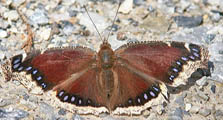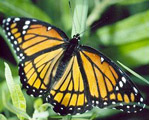Native Plants
Search for native plants by scientific name, common name or family. If you are not sure what you are looking for, try the Combination Search or our Recommended Species lists.
Salix discolor
Salix discolor Muhl.
Pussy Willow, Glaucous Willow
Salicaceae (Willow Family)
Synonym(s): Salix ancorifera, Salix conformis, Salix crassa, Salix discolor var. overi, Salix discolor var. prinoides, Salix discolor var. rigidior, Salix fuscata, Salix prinoides, Salix sensitiva, Salix squamata
USDA Symbol: SADI
USDA Native Status: L48 (N), CAN (N)
Pussy willow is a narrow shrub or small tree usually to 20 ft. with multiple trunks and dark-gray, scaly bark. The familiar, silvery-gray, furry catkins appear before leaf emergence. Deciduous leaves are broad, bright-green and shiny. Many-stemmed shrub or small tree with open rounded crown; silky, furry catkins appear in late winter and early spring.
The large flower buds burst and expose their soft silky hair, or "pussy fur," early in the year. In winter, cut Pussy Willow twigs can be put in water and the flowers forced at warm temperatures. Some twigs will produce beautiful golden stamens, while others will bear slender greenish pistils. The Latin species name refers to the contrasting colors of the leaf surfaces, which aid in recognition. Pussy willow catkins are the first willow catkins to appear each year and are recognized as a sign of spring. (Kershaw)
Plant Characteristics
Duration: PerennialHabit: Shrub
Leaf Retention: Deciduous
Leaf Arrangement: Alternate
Leaf Complexity: Simple
Fruit Type: Capsule
Size Notes: Up to about 25 feet tall, often shorter.
Leaf: Green
Fruit: Brown
Bloom Information
Bloom Color: White , Green , BrownBloom Time: Feb , Mar , Apr , May
Distribution
USA: CT , DE , IA , IL , IN , KY , MA , MD , ME , MI , MN , MO , MT , NC , ND , NH , NJ , NY , OH , PA , RI , SD , VA , VT , WI , WV , WYCanada: AB , MB , NB , NL , NS , NT , ON , PE , QC , SK , YT
Native Distribution: Nf. to B.C., s. to VA, KY, n. WY & c. ID
Native Habitat: Marshy, low ground; stream banks; ditches
Growing Conditions
Water Use: HighLight Requirement: Sun
Soil Moisture: Moist
Soil pH: Circumneutral (pH 6.8-7.2)
CaCO3 Tolerance: Medium
Soil Description: Damp soils.
Conditions Comments: Short-lived and fast-growing, pussy willows should by cut back heavily every few years to encourage lots of vigorous new growth. This plant is susceptible to insect, disease, and wind damage and tends to sucker to the point of being invasive if given continuously moist soil.
Benefit
Use Wildlife: Early season harvest for songbirds, waterfowl and small mammalsConspicuous Flowers: yes
Attracts: Butterflies
Larval Host: Mourning Cloak, Viceroy
Value to Beneficial Insects
Special Value to Native BeesSpecial Value to Bumble Bees
Special Value to Honey Bees
This information was provided by the Pollinator Program at The Xerces Society for Invertebrate Conservation.
Butterflies and Moths of North America (BAMONA)
|
Mourning Cloak (Nymphalis antiopa)  Larval Host |
Viceroy (Limenitis archippus)  Larval Host |
Propagation
Description: Willows are among the easiest of all plants to root from cuttings. Semi-hardwood or hardwood stem cuttings and root cuttings will root readily in any well-drained media without hormone treatment. Propagation is also accomplished by sowing fresh, untreatCommercially Avail: yes
Mr. Smarty Plants says
Decline in willow tree in West Virginia
June 15, 2008
I planted a willow tree about three years ago and it was progressing just beautifully with full leaves this spring in a nice green color. We staked it back about three weeks so it would grow straight...
view the full question and answer
National Wetland Indicator Status
| Region: | AGCP | AK | AW | CB | EMP | GP | HI | MW | NCNE | WMVE |
| Status: | FACW | FACW | FACW | FACW | FACW | FACW | FACW |
From the National Organizations Directory
According to the species list provided by Affiliate Organizations, this plant is on display at the following locations:Delaware Nature Society - Hockessin, DE
Bibliography
Bibref 1186 - Field Guide to Moths of Eastern North America (2005) Covell, C.V., Jr.Bibref 1185 - Field Guide to Western Butterflies (Peterson Field Guides) (1999) Opler, P.A. and A.B. Wright
Bibref 1258 - Trees of Ontario (2007) Kershaw, Linda
Search More Titles in Bibliography
Web Reference
Webref 38 - Flora of North America (2019) Missouri Botanical Garden, St. Louis, MO & Harvard University Herbaria, Cambridge, MA.Webref 23 - Southwest Environmental Information Network (2009) SEINet - Arizona Chapter
Additional resources
USDA: Find Salix discolor in USDA PlantsFNA: Find Salix discolor in the Flora of North America (if available)
Google: Search Google for Salix discolor
Metadata
Record Modified: 2023-05-16Research By: TWC Staff